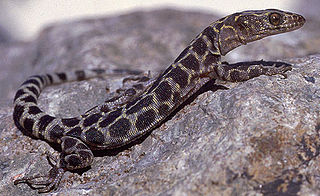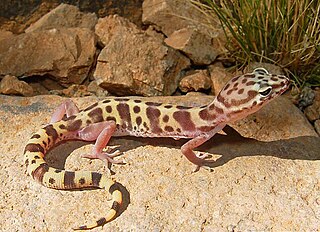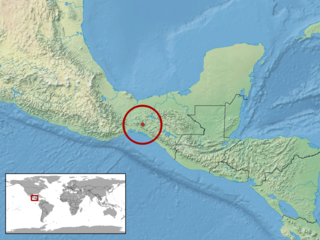
The greater earless lizard is the only species in the monotypic genus Cophosaurus. It is closely related to the smaller, lesser earless lizards and other species in the genus Holbrookia, and in fact was placed in that genus and referred to Holbrookia texana from 1852 into the 1970s. Earless lizards lack external ear openings, an adaptation to burrowing in the sand, as are the recessed lower jaw and flared upper labial scales. Greater earless lizards are sexually dimorphic, males grow larger and are more colorful than females, exhibiting pink and green colors that are particularly bright in the breeding season. Two bold black bars mark the lateral region of males but are greatly reduced and vague, or occasionally entirely absent in females.

Lepidophyma is a genus of lizards, commonly called tropical night lizards. The genus Lepidophyma is one of three genera of night lizards, which are a group of viviparous (live-bearing) lizards. There are 20 species of tropical night lizards in the genus Lepidophyma, making it the most populous night lizard genus. Species of the genus Lepidophyma are distributed throughout Central America, found anywhere from central Mexico to Panama, depending on the particular species. Tropical night lizards, particularly the yellow-spotted species, are sometimes called Central American bark lizards by pet dealers and owners.

Xantusia is one of three genera of night lizards. Species of Xantusia are small to medium-sized, viviparous (live-bearing) lizards found in the U.S. Southwest and in northern Mexico.

The island night lizard is a species of night lizard native to three of the Channel Islands of California: San Nicolas Island, Santa Barbara Island, and San Clemente Island. A small number of island night lizards also live on Sutil Island, near Santa Barbara Island.

Arend Friedrich August Wiegmann was a German zoologist and herpetologist born in Braunschweig.
The rock horned lizard or Ditmars' horned lizard is a species of phrynosomatid lizard endemic to Sonora in northern Mexico, south of the Arizona border. Bearing the shortest horns of all the horned lizards, it lives in thorn-scrub and deciduous Sinaloan woodlands. The rock horned lizard was "lost" to science for about 65 years. It has a unique habitat preference and limited distribution. It also had a very imprecise holotype locality record which made it difficult to locate. An extraordinary effort by Vincent Roth based on a cross-correlational analysis of gut contents from only three specimens led to its rediscovery.

The granite night lizard is a species of xantusiid lizard endemic to North America.
Hobart Muir Smith, born Frederick William Stouffer, was an American herpetologist. He is credited with describing more than 100 new species of American reptiles and amphibians. In addition, he has been honored by having at least six species named after him, including the southwestern blackhead snake, Smith's earth snake, Smith's arboreal alligator lizard, Hobart's anadia, Hobart Smith's anole, and Smith's rose-bellied lizard. At 100 years of age, Smith continued to be an active and productive herpetologist. Although he published on a wide range of herpetological subjects, his main focus throughout his career was on the amphibians and reptiles of Mexico, including taxonomy, bibliographies, and history. Having published more than 1,600 manuscripts, he surpassed all contemporaries and remains the most published herpetologist of all time.

Bezy's night lizard is a species of lizard in the family Xantusiidae. The species is endemic to Arizona.

Drymobius margaritiferus, commonly known as the speckled racer, is a species of nonvenomous colubrid snake native to the Americas. The specific name, margaritiferus, means "pearl-bearing" in Latin, referring to the pearl-like spots on the dorsal scales.

The tiger rattlesnake is a highly venomous pit viper species found in the southwestern United States and northwestern Mexico. No subspecies are currently recognized. The specific name tigris,, refers to the many narrow dorsal crossbands, which create a pattern of vertical stripes when viewed from the side.

The western banded gecko is a species of lizard in the family Eublepharidae. The species is native to the southwestern United States and adjacent northwestern Mexico. Five subspecies are recognized.

Abronia deppii is an endangered species of arboreal alligator lizard in the family Anguidae. The species was described in 1828 by Arend Friedrich August Wiegmann, and it is endemic to Mexico.

Abronia ornelasi is a species of arboreal alligator lizard in the family Anguidae. The species, which was originally described in 1984 by Jonathan A. Campbell, is endemic to southern Mexico.

Ira Loren Wiggins was an American botanist, Curator of the Dudley Herbarium, and Director of the Natural History Museum (1940–1962) at Stanford University. He was a Stanford faculty member from 1929 until his retirement in 1964. He was the first recipient of the Fellow's Medal of the California Academy of Sciences. His Flora of Baja California is a standard work on the botany of the Baja peninsula and on the many islands of the Gulf of California.
The bolsón night lizard is a species of night lizard in the family Xantusiidae. The species, which was originally described by Robert G. Webb in 1970, is endemic to the state of Durango in Mexico. Not much is known about the lizard at present, as it appears to be simultaneously rare and rather secretive in nature.

Holcosus chaitzami, also known commonly as Chaitzam's ameiva, is a species of lizard in the family Teiidae. The species is native to extreme southern North America and Central America.
Xantusia sanchezi, Sanchez's night lizard, is a species of lizard in the family Xantusiidae. It is a small lizard found in Mexico.













